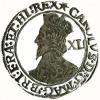LOL Welcome Rob. Bottom line is that coins can be handled if it's done carefully, however if you just look at the coins in your change you will see that the toning (original colour) and lustre (sheen) of newly struck copper coins can go quite quickly if they are exposed to certain conditions. The important thing is not to touch the top or bottom surfaces (obverse/reverse) as the moisture and oils on your fingers will leave traces that will darken with time. Of course, there is nothing wrong (to my eyes at least) with a toned copper or bronze coin. Here's one of mine (Copper, about the size of an old shilling and with (I think) a nice chocolate brown tone, though slightly different 'in the hand' as I edited the seller's pics as I've yet to get round to taking my own photos!): Obviously it's still preferable to only pick them up by the edges, avoid dropping the things and don't give them to children with jammy fingers to play with. Alternatively for the better/ pricier coins capsules made of plastic can be used. However I sympathise in that I too like to handle my coins. Mine however are generally silver and have been around for a few hundred years so being picked up is less likely to leave marks than shiny copper. But if you're not aiming for 'as struck' examples or proofs then, why not. You'll still probably want something (a file or box) to store them in. You don't want them knocking against each other, exposed to damp or salty air. Also avoid coins with verdegris (that green deposit you can find on copper) as it can spread. Look for clean coins with 'eye appeal' and you should be OK. Chris (forum owner) publishes and stocks a number of books on coins that might help. Plus (I think out of print but still available) there's a grading book by Derek Allen (another member here) which might be of interest still on Amazon if you have a Kindle. Not sure if there's an ePub version - you'd need to ask Chris about that. Grade (condition/wear) affects price, so it's something you may need to consider. Plus with many coins (and pennies in particular) there are many minor different varieties. But in many cases you need a coin in reasonable condition to be able to tell the difference as they can be small. What I originally did with shillings was try to collect the first year of issue and then an example of each major change in design. That might be more practical than a coin from each decade as some reigns there are many varieties, others few? Budget? Down to personal preference really. Some here only collect coins that look as if they were made an hour ago. Others, so long as they can identify what it is, they are happy. OK, better grade coins will normally keep their value if ever you sell. But it's a hobby and there's no point collecting things you don't enjoy collecting or because someone else says that's best! Collect what you like. But don't be surprised if that changes over time. It certainly did with me.
 Coinpublications.com
Coinpublications.com



